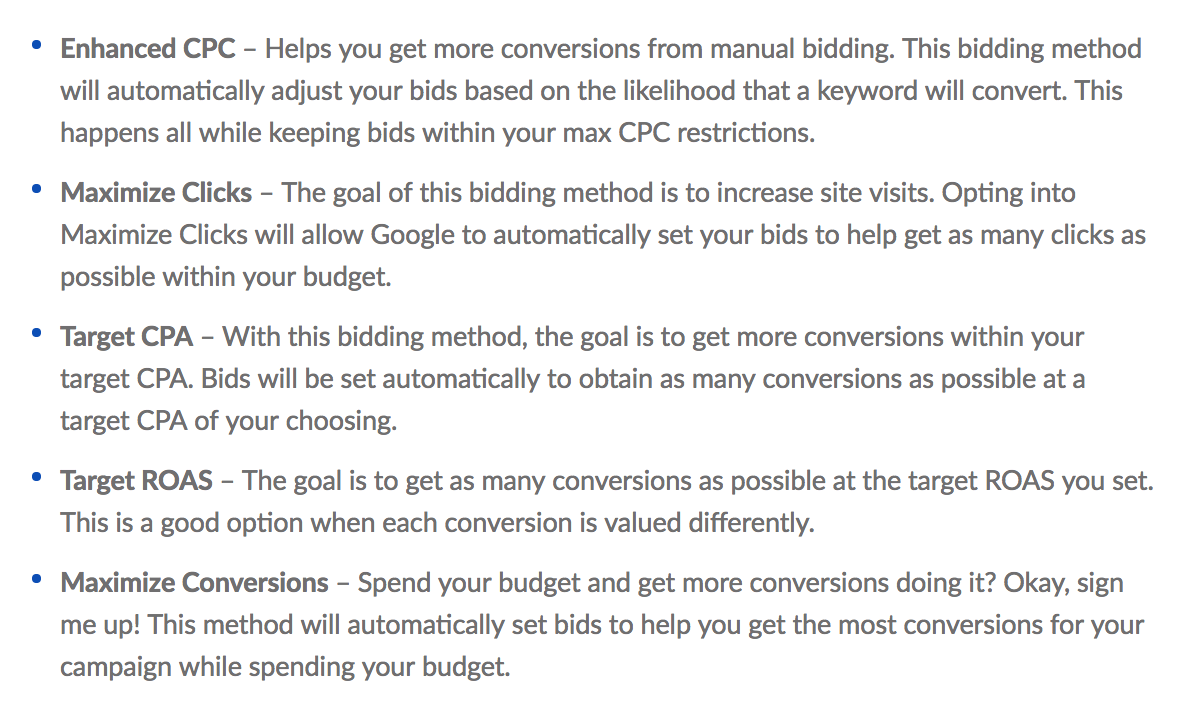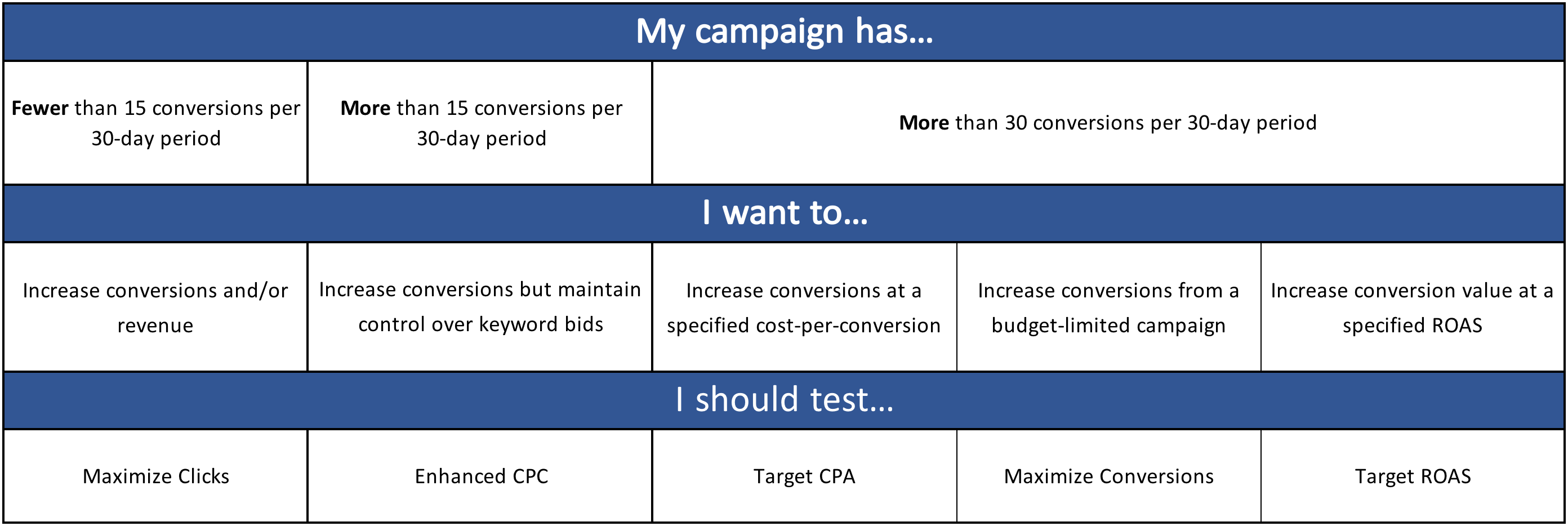You’ve worked hard to create a stellar website. You’ve built quality Google Ads campaigns and used experiments to find the best post-click landing pages for each audience. You’ve iterated and reiterated ad copy tests, while managing your keyword bids and budgets faithfully. Maybe you’ve even spent some time with click-triggered events in GTM to make sure all your conversions track correctly. And yet, you’re still struggling to meet CPA goals or grow your account.
It’s time to let the robots start helping out.
You’re doing all the right things, but don’t have enough time to perfectly oversee every keyword bid, budget, ad variation, and audience target. Fortunately, you are a savvy technical marketer and are ready to take advantage of machine learning to get even more from your PPC dollars. One of the best tests to run as you explore the world of automation and machine learning is with Google Ads Bidding strategies.
How Google Ads Smart Bidding uses machine learning for more powerful bid automation
Google Ads introduced Smart Bidding strategies back in 2016, building on previous automated bidding options announced as early as mid-2010. Over the past two years, Smart Bidding has continued to expand and grow more powerful. Google has added two new strategy goals, and the supporting algorithms continue to evolve as machine learning becomes more advanced. The full list of available strategies is reviewed below, but first let’s consider how and why Smart Bidding works.
Every Google search user carries several identifying characteristics, or “signals.” These include things like:
- Device
- Location
- Gender
- Age
- Income level
- Time of day
- Day of week
Google shows advertisers aggregations of performance from any of these signals or, in some cases, even a combination of two or more. Experienced PPC managers know that it is wise to implement bid modifiers for signals whose aggregated performance differs notably from the norm. At the same time, however, they also recognize that no one can ever perfectly cover every variation and combination of signals that may arise.
To make matters even more complicated, there are other signals which require all-or-nothing decisions when confronted manually:
- Geographic settings can be set to include users interested in your target locations, in addition to those physically present
- Text ads may be eligible to show on all Search Network partners, or opt for none at all
- Campaign and ad group settings can utilize selective automation for “Optimized” ad rotation that considers various ad characteristics
Several signals are completely invisible within the Google Ads data segments, including browser and operating system, prior website interactions, product attributes, among others (see the full list of automated bidding signals). Furthermore, even if the data were available to analyze, there is currently no way to manually modify bids based on these hidden signals:

Enter machine learning.
Google Ads machine learning tracks and analyzes every visible and hidden signal from every search and every click. Machine learning can pick out the minute-yet-significant variations in user behavior that stem from differences in demographics, device use, and expressed or inferred interests and preferences. Those signals are then cross-referenced with performance data, such as historical click- and conversion rates, and bids are increased or decreased to meet your selected target.
Ultimately, machine learning is an extremely dynamic and data-driven approach, which gives it the potential to be a powerful tool in your PPC arsenal.
Comparing the benefits of common Smart Bidding strategies
Before testing any Smart Bidding, be sure you understand the reasons for NOT using an automated PPC bidding strategy. If you are certain your campaigns meet the requirements for Smart Bidding success (15 or 30 conversions/30 days, only quality conversion actions reported in the “Conversions” column, no upcoming campaign End Dates), the next task is to determine which bidding strategy best fits your need.
There are currently four automated bid strategies supported by Google Ads Smart Bidding:
- Enhanced CPC
- Target CPA
- Target ROAS
- Maximize Conversions
While not technically a Smart Bidding strategy (because it focuses on traffic rather than conversions), Maximize Clicks is also commonly considered when discussing Smart Bidding options.
To reap the benefits of Smart Bidding, you must consider the goals of each strategy in coordination with your own:

Choosing the right Smart Bidding strategy to test
Each Smart Bidding strategy option has its own unique approach to driving high-quality traffic, engagement, and conversions. These approaches determine the underlying algorithm used to manipulate your campaign, ad group, and keyword bids. Thus, making the appropriate choice is crucial to successful application.
To navigate the options more easily, you can use the chart below to identify which Smart Bidding strategy you should test first to meet your goals:

It is recommended to test new bidding strategies through Google Ads Experiments, which allows you to directly compare performance to your previous bid strategy over the examined period of time.
Determining if Smart Bidding is working for you
Once your experiment has launched, it can be challenging to determine whether the Smart Bidding is actually working in your favor. Google Ads shows results compared to the source campaign when viewing any tab within an experiment:

With a well-named experiment, though, you can more easily see performance compared by downloading a simple Campaign report and examining KPIs for your source campaign and the experiment side-by-side (or row-by-row, in this case).
Example 1: Maximize conversions
One recent experiment concluded on behalf of a lead generation client shows how the Maximize Conversion strategy was able to dramatically improve performance in a budget-limited search campaign.
The test was launched in two campaigns that were driving consistent lead volume at a lower-than-average CPA. Since the leads from these particular campaigns were harder to close internally, the goal was to generate more leads without investing additional spend. The Maximize Conversions bid strategy was able to increase traffic, engagement, and conversion metrics, with a lower total cost and decreased cost/conversion:

Both campaigns testing Maximize Conversions with experiments saw more conversions at a lower CPA than their Enhanced CPC counterparts. Therefore, and so the Maximize Conversions strategy was applied fully and has continued to perform well.
A result like this is one that everyone wants to see when examining their campaign experiments, but unfortunately, most are not quite this ideal.
Example 2: Target CPA
Consider another experiment from a lead gen account, in which Target CPA was tested to increase lead volume at a specified cost-per-conversion, and results were not at all clear-cut.
This test was launched in two campaigns that historically generated high-quality leads, but where the cost/conversion had been creeping up over time. Since the campaigns were not limited by budget, the goal was to optimize ad delivery to reduce wasted spend for users unlikely to convert. The Target CPA bid strategy was able to reduce cost while increasing conversion rate, but came at the price of lower traffic and conversion volume:

Both campaigns saw mixed results, and the final determination was made based on the original goals of the experiment. Target CPA is known to limit traffic at times to prevent exceeding the CPA bid, but it did effectively reduce the cost-per-conversion by reducing wasted spend and focusing ad delivery on high-quality searchers. The decrease in impressions, clicks, and conversions was overlooked in favor of more efficient bidding to generate high-quality leads at a lower cost.
Closing thoughts
Smart Bidding is designed to get more of the best users to your post-click landing pages. However, it should be understood that the algorithms may deliver on that promise differently. At times, they will accomplish it primarily by supplying a larger quantity of traffic. Other times, traffic may decrease in favor of driving higher quality users to your site or post-click landing page.
If the results of your experiment are mixed, remember to reflect on your initial goals when determining a winner, and consider adjusting variables where needed to find the most effective bid strategy for each of your campaigns.
